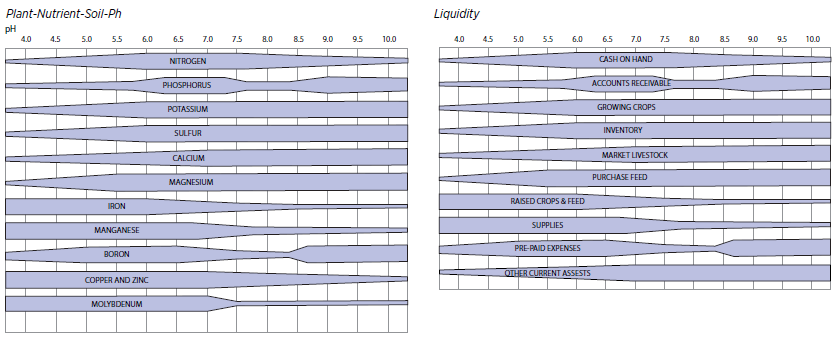
Understanding the Farm's Financial Health: Basic Components to a Successful Business
DOWNLOADNovember 28, 2018 - Jonathan LaPorte, Michigan State University Extension
Understanding your farm’s financial health is the key to successfully meeting your farm goals. Michigan State University (MSU) Extension farm management educators want to help you understand this key concept.
That first sentence may sound strange at first. When you attend an informational meeting about successful farming, financial health is often not normally the topic of conversation. Almost always, a discussion on finances centers on achieving better production, marketing for higher prices or lowering expenses. But without understanding what your financial health is and how it influences production, how do you know what improvements to make or market prices you need to be successful?
Still not convinced? Let’s look at another activity often considered influential to farm activities: soil testing. We know that the results of a soil test can tell us a lot about the farm – from available nutrients to soil structure and even overall soil condition. We use this information in shaping fertilizer programs, chemical uses, irrigation scheduling and even yield goals. However, these tests will also help us to discover unknown problems or challenges that may be holding back or limiting success.
For example, one farm’s soil test reveals that the pH has a lime index of 67 and a pH of 5.9. The farmer wants to have the pH at 6.5 and from the test results, determines 2.5 tons of lime needs to be applied. The farmer applies 2.5 tons to that plot of land and raises the pH. Because the farmer was aware of the challenge, the right solutions were found and implemented to overcome them. This made the soil test an important tool as it provided information to help make a decision that will have an impact on the farm throughout the year.
The value of understanding your farm’s financial health is similar to the value found in soil testing.

How is understanding financial health even valuable?
Financial health is a measure of the farm’s financial situation, which describes the business’ current profitability and productivity. As margins get tighter, managers know they must do more with less and become more efficient in order to survive. Just like knowing the results of a soil test, knowing the financial situation provides knowledge about where efficiencies already exist and where improvement efforts should start.
The questions asked when considering a soil test are similar to those asked when considering the farm’s financial health. How much do we have to work with already? Do we have any available assets that can be helpful? How much do we need to add to our plans to reach our goal? The answers to these questions give us a foundation and a starting point from which to form a plan.
Think about what your farm currently has to work with from a financial health perspective. Do you know how efficient the farm is? What available assets are you using or not using towards those farm goals? What areas could improvements be made?
Keep these ideas in mind as we dive further into the value of understanding the farm’s financial health.
Digging deeper into your farm’s financial health.
Like a soil test, we have to collect our core samples from which we will analyze our farm’s information. The core samples of a “financial” soil sample are found in gathering or creating three important documents. These are a balance sheet, an income statement, and a cash flow statement.
The balance sheet is a snapshot in time of a business’ assets, liabilities, and net worth (i.e. owner equity). It tells us whether the farm’s cash flow is enough to cover debts within the normal course of the year or if the farm were forced to liquidate; giving us a snapshot of what our financial situation is at the moment. It focuses on two main concepts; liquidity and solvency.
Liquidity is the ability of the business to meet financial debts as they come due. It measures this ability by looking at three ratios: current ratio, working capital, and working capital to gross incomes. These ratios can be found in detail under the Farm Financial Ratio series by Adam Kantrovich on the MSU News webpage.
In thinking about liquidity, let’s go back to our soil test example. This would be similar to knowing if we had enough available nutrients to meet the plant’s needs and reach our yield goal. Do we have enough? Do we need to add more? How should we begin planning to add them?

The next important document is the income statement. It measures profitability and how the business got to its current financial situation over a period of time.
Profitability is the difference between the value of goods produced and the cost of the materials used to make them. This could be used to cover family living, taxes, or reinvested into the business, which increases your farm’s net worth. It focuses on a number of different ratios, including net farm income, rate of return on assets, rate of return on equity, operating profit margin, and earnings before interest, taxes, depreciation, and amortization (EBITDA). Each of these measure the farm’s profit that is returned from investments in capital, land, labor, and even management.
How would we think about profitability with a soil test? Did we reach our goal with what we put towards it? What did we get back for our efforts in the growing season? After we’ve paid for everything, is there anything left over that could be used for investing in other things or even used next year?
Get your hands dirty with a soil test or farm financial test, both yield valuable findings.
The final core sample for our test is the cash flow statement. This is actually a combination of the balance sheet and income statement. It takes information from both and explains what the sources of income were and how they were used by the farm. It focuses on Repayment capacity or the ability to repay scheduled term debt and the farm’s ability to take on additional term debt. It also shows the farm’s ability to repay term debts on time.
Repayment capacity is not considered a measurement of the business’ performance. Instead, it looks at what dollars remain after paying for operating, investing, and financing activities. The remaining dollars can then be used for future years. To evaluate these things, it focuses on the capital debt repayment capacity, capital debt repayment margin, replacement margin, term-debt coverage, and replacement margin coverage ratios.
This is the point where everything we’ve been studying in our “financial” soil test starts to come together. We know what resources are available to be used. We also know how we’ve invested those resources over time. Most importantly, we now know what we have left over for next year. With this information we can start to answer some important questions about the farm business.
What is the farm’s operating capacity or size compared to its desired goals? Is it operating at, above, or below its ability to successfully reach them? What is the farm’s ability to meet goals and repay term debt? What changes should be considered?
These financial documents are critical pieces to understanding your farm’s financial health. Individually, they tell you about specific strengths and weaknesses that may be holding back your farm’s success. They can even reveal opportunities for business growth. Most importantly, you can begin to understand your farm’s financial efficiency.
The farm is making money, why should I worry about efficiency?
Financial efficiency shows the effectiveness of your management decisions. The decisions you’ve made in the past often impact the potential for future successes. Especially if the same decisions are made over and over again. To find how efficient your farm is, begin by evaluating the farm’s asset-turnover rate. This focuses on how well the farm uses its assets to generate income.

Then assess where gross farm income is being spent by looking at the operating expense ratio, depreciation expense ratio, interest expense ratio, and net farm income ratio. With all four adding up to 100%, these help the farm manager to know how effectively income is being used across the farm. Think about what it takes to generate just one $1 dollar of revenue. These ratios tell us how many pennies of that dollar went towards operating expenses, depreciation expense (maintaining net worth), interest expense (debt), or ended up as profit to the farm.
Next, compare this to our soil test example once more. When we start to think about how effectively our past practices have been, have we utilized our resources the best way possible to reach our goals? Are we getting the most out of what we’re putting in to the operation? Are there any limiting factors that we still need to address? What changes can we make now or work towards that would allow us to better improve our profitability and farm growth?
Think about these concepts on your own farm. How does your farm’s repayment capacity affect the liquidity or ability to pay bills? How does it affect the solvency or available assets you have to use to reach farm goals? How does the farm’s profitability play into the repayment of debt?
Most importantly, how are your management decisions impacting the answers to all of these other questions?
Using the analysis of farm financial health makes it valuable. It puts you in control.
Just like taking a soil sample, we need to think about when we test our farm’s financial health and review those critical financial documents. Reviewing them does not have to happen every day, but awareness of what’s in them should be ongoing throughout the year. Routinely take time to look at your records and get an idea of what is going on in the checkbook. Set aside time at least once a year for a more in-depth review, preferably prior to meeting with your lender or tax preparer.
Why review the farm’s financial health before meeting the lender or tax preparer?
Farm managers often forget that they are still the decision makers.
This is never more true than when meeting with lenders or tax preparers. The lender approves a loan request and the tax preparer ensures taxes are filed correctly, but who leads the financial discussion? Who knows what the farm’s plan is, the challenges to that plan, and how they are going to be addressed? That responsibility always falls to the farm manager. If you wait for the lender or the tax preparer to tell you these things, it is unlikely your farm will be successful long-term.
Keep in mind that as the decision maker, you are meeting with these individuals to discuss the plan, and not the problems, for your operation to continue moving forward. The lender is there to consider a financial investment in the farm and can offer recommendations to fine-tune the plan so that it is successful. A tax preparer is aware of tax laws and can offer options on how the business can best management their liability. While these are important resources to assist in the plan’s success, they are still just resources. Resources don’t have to live with the consequence of a poorly designed plan. As the farm manager…you do. Take the lead of those discussions by knowing what your farm’s financial health is before walking through their doors.
This is especially important in times of a challenging farm economy. During times like these, there are tightening margins, greater uncertainty in the market place, and added weight on making the right decisions. The most difficult of these is knowing what the right decisions are for a farm to stay profitable and productive. This places a renewed focus on better information in order to minimize potential risks.
So, begin collecting those core samples today. Look over the farm’s latest financial statements and take your own “financial” soil sample of the farm. Start to learn where your farm’s financial health is right now. Because the best resource for finding opportunities for furthering your farm’s success are right there on the farm itself.




 Print
Print Email
Email

